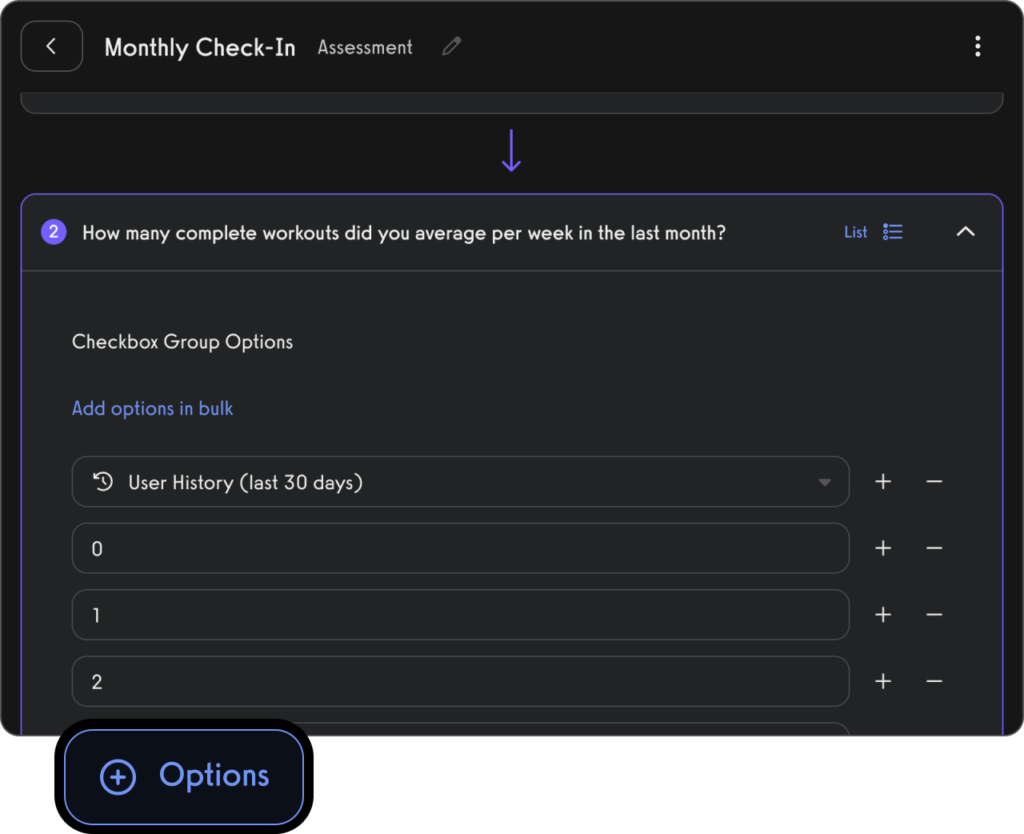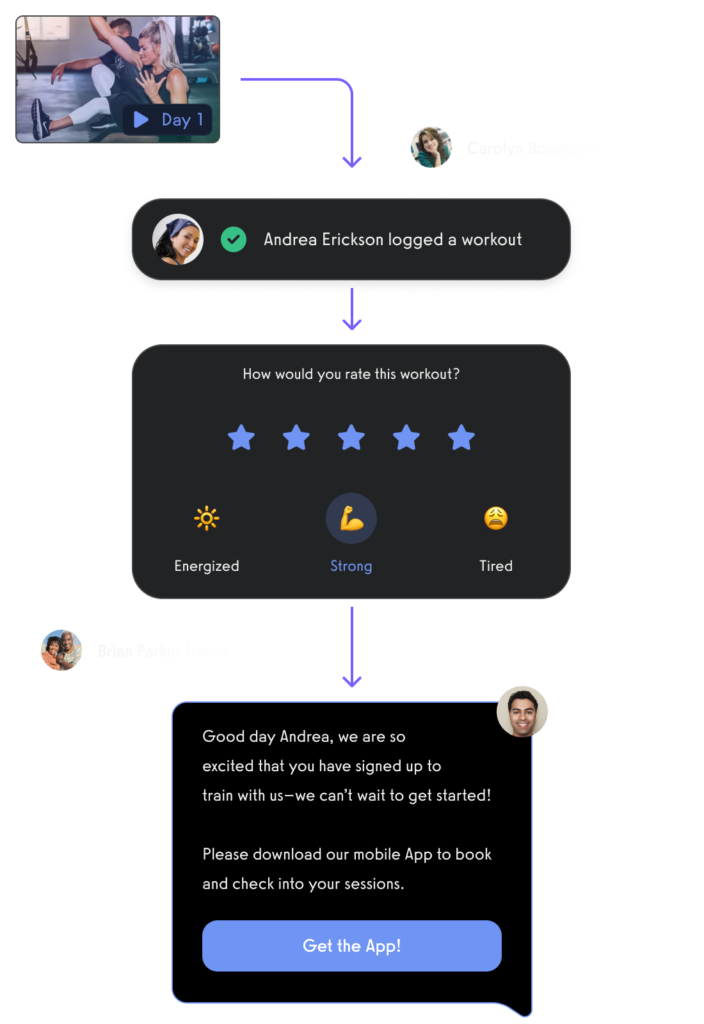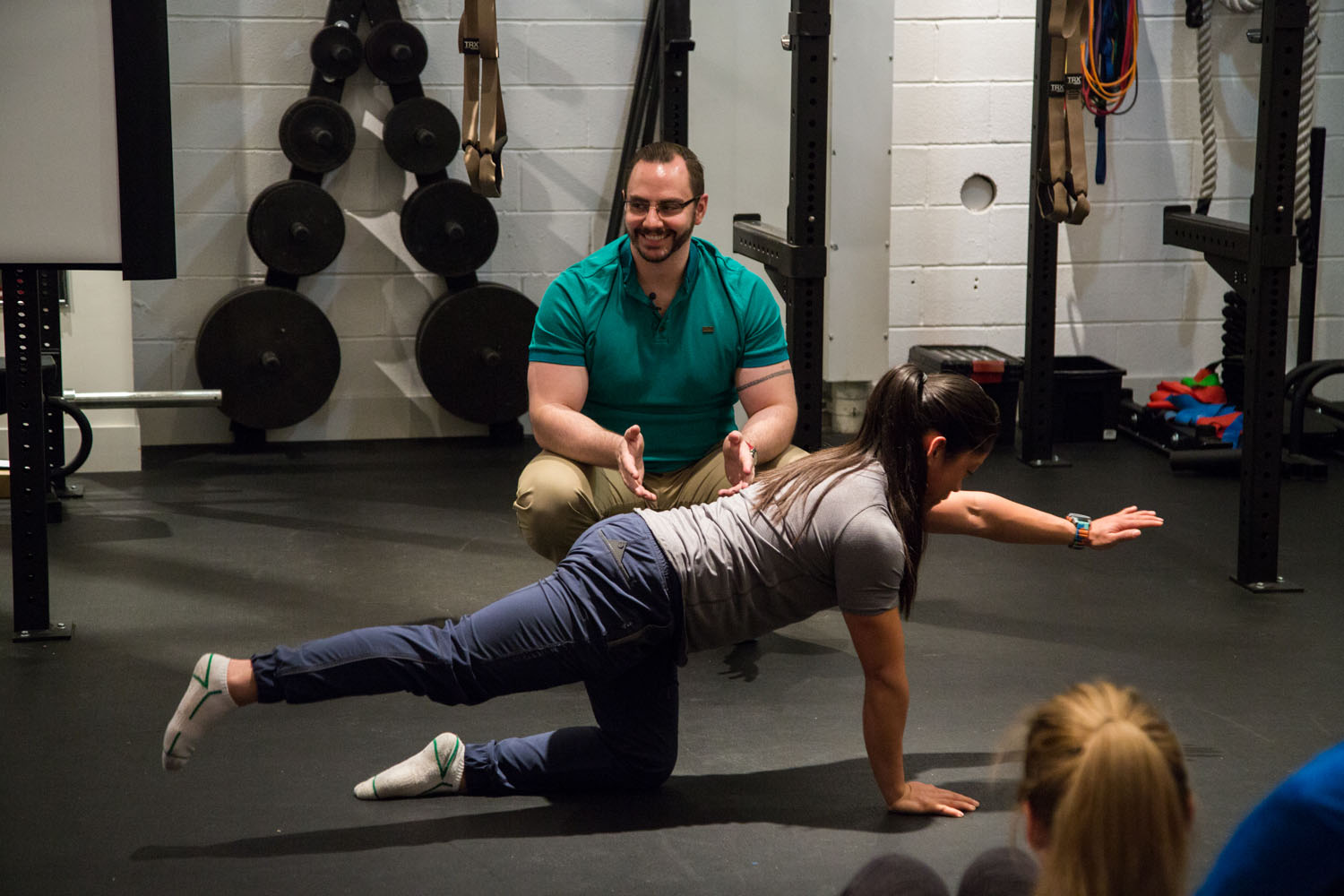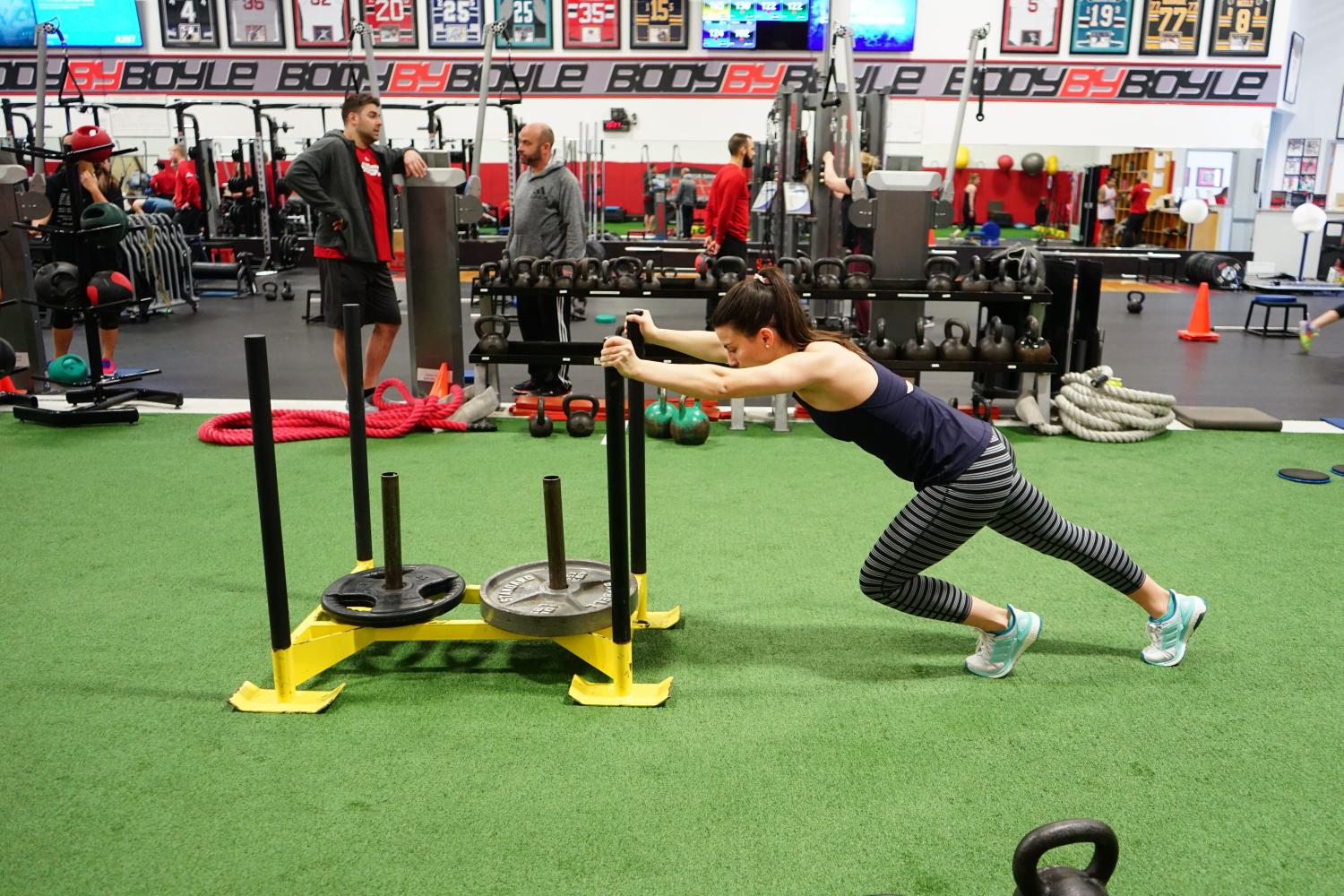Fitness Assessment Template (PDF, DOC, XLS – FREE)
Get a free fitness assessment template you can download in PDF, DOC, and XLS. Then modify this fitness assessment form to use as needed with your clients.

Looking for a comprehensive fitness assessment template? Get a free fitness assessment template below and then learn all about fitness assessment best practices and how you can use the best fitness assessment software. Use our starter fitness assessment template, and then in this article, we will explore the importance of conducting fitness assessments and delve into every key component that should be included in a well-designed fitness assessment template that you can use with clients, so that you can modify the free personal trainer fitness template as needed.
A well-structured fitness assessment template is a crucial tool for personal trainers and gym owners to evaluate clients’ starting fitness levels and track their progress over time. Offering a personal training assessment template or a basic fitness assessment PDF allows trainers to easily gather information on client goals, physical capabilities, and areas for improvement. For those looking to set a strong foundation, our baseline fitness test template provides an excellent way to measure key fitness indicators like endurance, strength, and flexibility. This fitness assessment form PDF is designed to streamline the assessment process, making it accessible for trainers of all experience levels.
Using a fitness test template or personal trainer assessment form not only helps track client progress but also enhances client engagement by providing clear, measurable outcomes. Trainers can document and compare results over time with a fitness evaluation form or fitness testing template, which can be printed or used digitally. Additionally, our printable physical fitness assessment form and physical fitness test template are ideal for capturing results during in-person sessions or virtual training assessments. This comprehensive approach ensures clients see their improvements, enhancing motivation and retention.

While downloadable templates are a helpful resource, Exercise.com offers a more advanced solution for managing assessments. With Exercise.com, trainers can conduct online fitness assessments, store client data securely, and automatically generate progress reports. This not only saves time but also allows trainers to keep client assessment records in one place, offering a seamless experience for both in-person and online clients. Exercise.com’s software enables personal trainers to focus on delivering results while leaving the logistics of fitness tracking and record-keeping to a robust, user-friendly platform.
And then to really send fitness assessments with a professional grade solution, be sure to check out our fitness assessment software so that you can easily create and send fitness assessments online.

No more manual fitness assessment PDF downloads, wrangling with fitness assessment templates in Word, and other headaches. Create and send fitness assessments for your clients to use in your very own custom branded fitness apps.

Hook them up to workout plans, waivers, invoices, automated messages, payments, use custom logic, have your clients upload photos and videos for mobility tests and progress photos, and much more.

And, of course, it’s all fully integrated into the best gym software and the best personal trainer software: Exercise.com.

Free Fitness Assessment Template Form
A Fitness Assessment Template is a valuable tool used by fitness professionals like gym owners, personal trainers, and online fitness coaches to evaluate a client’s physical abilities, measure progress, and develop tailored fitness plans. Here’s a comprehensive template that you might find helpful:
Fitness Assessment Template
Client Information:
- Name: ___________
- Age: _____________
- Gender: __________
- Contact Information: __________
- Occupation: __________
- Emergency Contact: __________
Health and Medical History:
- Current Medications: __________
- Previous Injuries/Surgeries: __________
- Known Allergies: __________
- Chronic Health Conditions: __________
- Family History of Health Issues: __________
Fitness Goals:
- Primary Goals (e.g., weight loss, muscle gain): __________
- Secondary Goals: __________
- Target Timeframe: __________
Lifestyle Information:
- Smoking/Alcohol Consumption: __________
- Diet Preferences/Restrictions: __________
- Sleep Patterns: __________
- Stress Levels: __________
Current Physical Activity:
- Exercise Frequency: __________
- Exercise Type/Intensity: __________
- Favorite Activities/Sports: __________
- Limitations/Concerns: __________
Measurements:
- Height: ___________
- Weight: ___________
- Body Mass Index (BMI): ___________
- Body Fat Percentage: ___________
- Waist Circumference: ___________
- Hip Circumference: ___________
- Blood Pressure: ___________
Strength Assessment:
- Push-ups (reps): ___________
- Sit-ups (reps): ___________
- Plank (time): ___________
- Squats (reps): ___________
Flexibility Assessment:
- Sit and Reach Test: ___________
- Shoulder Flexibility Test: ___________
Cardiovascular Assessment:
- Resting Heart Rate: ___________
- 3-Minute Step Test: ___________
- 12-Minute Run/Walk Test: ___________
Assessment Summary and Recommendations:
- Strengths: __________
- Areas for Improvement: __________
- Personalized Workout Plan: __________
- Nutritional Guidance: __________
- Follow-up Schedule: __________
Assessor’s Signature:
- Name: __________
- Date: __________
- Signature: ____________________
Client’s Acknowledgment:
- Name: ____________________
- Date: ____________________
- Signature: ____________________
Please note that a fitness assessment should always be performed by a qualified fitness professional like a personal trainer, and the above personal training fitness assessment form template should be customized according to individual needs and goals. It might also be integrated into a custom branded fitness app like Exercise.com, where fitness professionals can manage various aspects of their business, including client assessments. You can create your own fitness assessments, customize existing fitness assessments, send them out in your own custom branded fitness apps and web platform, and more.
Book a demo with Exercise.com to learn more about how it can provide a professional solution for your fitness business.

Why Conduct a Fitness Assessment?
Before we dive into the specifics of fitness assessment templates, let’s first understand why conducting a fitness assessment is essential. The primary goal of a personal trainer fitness assessment form is to gather baseline information about an individual’s current physical condition. By assessing various aspects of fitness, such as cardiovascular fitness, muscular strength and endurance, flexibility, body composition, balance, and coordination, a fitness assessment allows you to identify strengths, weaknesses, and areas that require improvement.
Additionally, a fitness assessment provides a starting point and helps establish realistic and personalized fitness goals. It also serves as a powerful motivational tool, as individuals can track their progress over time and witness the improvements they make through their dedicated efforts. Moreover, fitness assessments are vital for ensuring the safety of individuals during exercise by identifying any potential health risks or limitations.

Read More:
Key Components of a Fitness Assessment
A comprehensive fitness assessment template should include the following key components:
- Gathering Basic Information: Personal Details and Health History
- Assessing Cardiovascular Fitness: Tests and Measurements
- Evaluating Muscular Strength and Endurance: Protocols and Tools
- Measuring Flexibility and Range of Motion: Techniques and Guidelines
- Analyzing Body Composition: Methods and Calculations
- Assessing Balance and Coordination: Exercises and Assessments
- Tracking Progress Over Time: Using the Fitness Assessment Template as a Monitoring Tool
- Interpreting Results: How to Analyze the Data from Your Fitness Assessment Template
- Identifying Areas for Improvement: Using the Assessment Findings to Set Goals
- Developing Personalized Exercise Programs Based on the Fitness Assessment Results
- Ensuring Safety during Exercise: Adapting Workouts to Individual Abilities and Limitations
- Repeating the Fitness Assessment: When and How Often Should It Be Done?
- Communicating Results to Clients or Patients: Creating Clear, Understandable Reports from the Template
- Increasing Client Engagement and Motivation through Regular Fitness Assessments
- Incorporating Technology into Your Fitness Assessments: Apps, Wearables, and Online Tools
- Challenges and Limitations of Using a Fitness Assessment Template
Each of these components plays a crucial role in creating a comprehensive and effective fitness assessment template. Now, let’s dive deeper into each component of free personal training assessment forms and explore them in exhaustive detail.
Setting Up Your Fitness Assessment Template
Creating a well-organized and user-friendly fitness assessment template is the first step towards conducting successful fitness assessments. Your template should be easy to navigate, include clear instructions for each assessment, and provide spaces for recording measurement data. Consider using a digital format or spreadsheet to enhance accessibility and facilitate data analysis. Make sure to customize your template based on the specific needs and goals of your clients or patients.
Gathering Basic Information: Personal Details and Health History
Prior to conducting any physical assessments, it is crucial to gather basic information about the individual, including their personal details and health history. This information will help you tailor the fitness assessment to their specific needs and identify any potential health risks or contraindications to certain exercises or tests. Obtain information such as age, gender, height, weight, medical conditions, current medications, previous injuries, and exercise habits.
By collecting this data before the physical assessments, you can ensure the safety and effectiveness of the entire process.
Assessing Cardiovascular Fitness: Tests and Measurements
Cardiovascular fitness is a key determinant of overall health and is often assessed through various tests and measurements. These assessments evaluate the ability of the heart, lungs, and circulatory system to efficiently deliver oxygen to the working muscles during physical activity. Tests may include the classic treadmill or cycle ergometer tests, step tests, or even the use of wearables to monitor heart rate and estimated VO2 max. The results obtained from these assessments provide valuable insights into an individual’s aerobic capacity and cardiovascular health.
It is essential to ensure that these assessments are conducted under safe and controlled conditions, with close monitoring of vital signs, and in accordance with established protocols.
Evaluating Muscular Strength and Endurance: Protocols and Tools
Muscular strength and endurance assessments allow you to gauge an individual’s ability to generate force and sustain muscular effort over time. Various protocols and tools can be used for assessing different muscle groups, including grip strength tests, one-repetition maximum (1RM) tests, push-up and sit-up tests, and plank holds. These assessments provide insights into an individual’s muscular capabilities, imbalances, and areas that need improvement. They also help in designing personalized resistance training programs.
When conducting muscular strength and endurance assessments, it is crucial to follow standardized protocols, pay attention to proper form and technique, and consider any limitations or injuries that may affect the results.
Measuring Flexibility and Range of Motion: Techniques and Guidelines
Flexibility and range of motion assessments measure the ability of joints and muscles to move through a full range without pain or restrictions. These assessments help identify tight muscles, joint limitations, and imbalances that may impede movement and increase the risk of injuries. Common tests include the sit-and-reach test, shoulder flexibility tests, and hip mobility assessments. By incorporating flexibility training into exercise programs based on the assessment results, you can enhance an individual’s overall physical performance and reduce the risk of musculoskeletal issues.
It is important to use appropriate techniques and guidelines during flexibility assessments to ensure accurate results and prevent injury. Take into account any pre-existing injuries or conditions that may impact flexibility.
Analyzing Body Composition: Methods and Calculations
Body composition assessments provide information about the relative amounts of fat, muscle, bone, and other tissues in an individual’s body. These assessments are crucial for determining overall health, assessing potential health risks related to excess body fat, and tracking changes resulting from exercise and nutrition interventions. Common methods include skinfold calipers, bioelectrical impedance analysis (BIA), and dual-energy X-ray absorptiometry (DEXA). Calculations such as body mass index (BMI) and waist-to-hip ratio (WHR) provide further insights into an individual’s body composition.
When conducting body composition assessments, it is essential to follow standardized protocols, consider the limitations of each method, and interpret the results in the context of overall health and fitness.
Assessing Balance and Coordination: Exercises and Assessments
Balance and coordination assessments evaluate an individual’s ability to maintain stability, control movement, and perform tasks requiring motor skills. These assessments are crucial for identifying any deficits or weaknesses that may increase the risk of falls or impact performance in sports or daily activities. Assessments can include single-leg balance tests, timed stands, and exercises that challenge coordination and proprioception. The results obtained from these assessments can guide the inclusion of balance and coordination exercises in training programs and help improve overall physical performance.
Ensure that assessments are conducted in a safe environment, with appropriate support and supervision if needed, and consider any specific factors that may affect balance, such as age or previous injuries.
Tracking Progress Over Time: Using the Fitness Assessment Template as a Monitoring Tool
An integral part of a fitness assessment template is the ability to track and monitor progress over time. By regularly repeating fitness assessments, you can objectively measure improvements and adjustments in various fitness components. This tracking not only provides motivation but also helps optimize training programs and personalize exercise interventions based on the individual’s changing needs.
Set a schedule for reassessments based on the specific goals and timeline of the individual. It is important to maintain consistency and use the same assessment tools, protocols, and conditions to ensure reliable and meaningful data comparisons.
Interpreting Results: How to Analyze the Data from Your Fitness Assessment Template
Once you have collected all the data from the fitness assessments, it is crucial to interpret the results accurately. Analyzing the data allows you to identify strengths, weaknesses, trends, and patterns that can guide exercise program design and goal setting. Consider using data visualization tools, such as charts or graphs, to facilitate the interpretation process and enhance understanding for both you and the individual being assessed.
Avoid jumping to conclusions based on isolated results and take a holistic approach when interpreting the data. Consider the interplay between various fitness components and how they relate to overall health and performance.
Identifying Areas for Improvement: Using the Assessment Findings to Set Goals
One of the primary purposes of a fitness assessment is to identify areas that require improvement. Utilize the assessment findings to provide individuals with specific feedback on their strengths and weaknesses. Engage in a collaborative discussion to establish personalized and realistic goals that align with their expectations and aspirations.
Setting goals based on assessment results helps individuals stay focused, motivated, and committed to their fitness journeys.
Developing Personalized Exercise Programs Based on the Fitness Assessment Results
With a thorough understanding of an individual’s fitness assessment results, you can design personalized exercise programs that target their specific needs and goals. Tailor the exercise program to address their weaknesses, build on their strengths, and take into account any contraindications or limitations identified during the assessment process. Ensure a well-rounded program that addresses all relevant fitness components and provides progressive challenges for optimal improvement.
Be sure to include flexibility exercises, cardiovascular training, resistance training, and balance and coordination exercises based on the individual’s assessment results.
Ensuring Safety during Exercise: Adapting Workouts to Individual Abilities and Limitations
An essential aspect of fitness assessment and program design is ensuring the safety of the individuals during exercise. Adapt workouts to their abilities, limitations, and any specific precautions indicated by the assessment results. Select appropriate exercise progressions, modify movements, or provide alternative exercises to accommodate their needs. Prioritize proper form and technique, and encourage individuals to listen to their bodies and communicate any discomfort or pain experienced during exercise.
Regular reassessments help monitor progress and ensure that adjustments to the exercise program are made as necessary to provide continued safety and effectiveness.
Repeating the Fitness Assessment: When and How Often Should It Be Done?
Repeating fitness assessments at specific intervals is essential for tracking progress, optimizing training programs, and maintaining motivation. The frequency of reassessments depends on various factors such as the goals, fitness level, and timeline of the individual. In general, reassessments every 4-12 weeks are recommended, but this can vary. Maintain consistency in assessment conditions and protocols to ensure accurate comparison of results.
Regular reassessments also provide an opportunity to celebrate achievements, identify new goals, and adjust exercise programs accordingly.
Communicating Results to Clients or Patients: Creating Clear, Understandable Reports from the Template
Effectively communicating the results of the fitness assessment to clients or patients is crucial for facilitating understanding, collaboration, and goal setting. Create a clear and concise report based on the template that was used for the assessments. Use visual aids like graphs or charts to illustrate the assessment results and highlight key findings. Explain the implications of the results in understandable terms, address any concerns or questions, and encourage the individual’s active participation in the goal-setting process.
By providing individuals with a comprehensive report, you empower them to make informed decisions and take ownership of their fitness journey.
Increasing Client Engagement and Motivation through Regular Fitness Assessments
Regular fitness assessments play a significant role in increasing client engagement and motivation. Through the continuous tracking of progress, individuals can see their hard work translating into tangible improvements. Use these assessments as opportunities to celebrate achievements, acknowledge progress, and re-evaluate goals. Additionally, encourage individuals to reflect on their journey, acknowledge personal milestones, and set new challenges to maintain long-term motivation and engagement.
Incorporating Technology into Your Fitness Assessments: Apps, Wearables, and Online Tools
Technological advancements have revolutionized fitness assessments, making them more accessible, efficient, and engaging. Embrace the use of fitness apps, wearable devices, and online tools that can streamline the assessment process, provide real-time data analysis, and enhance the overall fitness experience for both the assessor and the individual being assessed. Take advantage of features such as automated data collection, progress tracking, and goal setting to enhance the effectiveness and convenience of your fitness assessments.

Remember to assess the reliability and accuracy of the technology used before incorporating it into your assessments.
See how Exercise.com can help you create fitness assessments and manage your entire fitness business in one place.
Challenges and Limitations of Using a Fitness Assessment Template
While fitness assessment templates provide a structured framework for conducting assessments, it is important to be aware of their challenges and limitations. Templates may vary in their comprehensiveness, applicability to diverse populations, and ability to address individual variability. It is crucial to adapt the template to the unique needs and goals of each individual and consider that assessments may not capture all aspects of fitness or health. Be mindful of potential biases, limitations of certain assessments, and the importance of contextual factors when interpreting the results.
Continued education, staying up-to-date with research, and seeking professional advice can help overcome these challenges.
With this comprehensive guide, you now have a solid understanding of the key components of a fitness assessment template and the importance of conducting regular fitness assessments. Remember, a well-designed fitness assessment template enables you to gather baseline data, tailor exercise programs, track progress, and ensure the safety and effectiveness of fitness interventions.
How do you create a fitness assessment?
Creating a fitness assessment involves identifying the client’s needs, goals, and current fitness level, then designing a series of tests and measurements that align with those factors. This might include questions about medical history, lifestyle, and nutritional habits, as well as physical tests for strength, flexibility, endurance, and body composition.
What are the 6 components of a fitness assessment?
The 6 components of a fitness assessment generally include:
- Body Composition
- Cardiovascular Endurance
- Muscular Strength
- Muscular Endurance
- Flexibility
- Balance and Coordination
What should be included in a fitness assessment?
A fitness assessment should include:
- A client interview to understand goals, medical history, and lifestyle.
- Evaluation of the six components of fitness.
- Specific physical tests tailored to the individual’s needs.
- A written report summarizing the findings, recommendations, and a plan to achieve goals.
What is a fitness assessment sheet?
A fitness assessment sheet is a document used to record the results of a fitness assessment, including measurements, test scores, observations, and any other relevant information. It often serves as a baseline for tracking progress over time.
What are the five components of fitness used to assess?
The five common components of fitness used to assess physical health are:
- Body Composition
- Cardiovascular Endurance
- Muscular Strength
- Muscular Endurance
- Flexibility
What are the 4 common fitness tests?
Four common fitness tests might include:
- The 1.5-mile run test for cardiovascular endurance.
- The sit-and-reach test for flexibility.
- The one-repetition max (1RM) test for muscular strength.
- The push-up test for muscular endurance.
What are the two types of fitness assessment?
The two main types of fitness assessments are:
- Health-Related Fitness Assessment: Focuses on overall wellness and disease prevention.
- Skill-Related Fitness Assessment: Evaluates specific athletic abilities like agility, balance, and power.
What to do during a fitness assessment?
During a fitness assessment, conduct interviews to understand the client’s goals and health status, perform various physical tests, observe and evaluate the results, provide feedback, and develop a tailored fitness plan.
What is a common fitness assessment used for senior fitness clients?
The Senior Fitness Test is commonly used, consisting of exercises that assess strength, endurance, flexibility, agility, and balance, such as chair stands, arm curls, and a 2-minute step test.
What is basic fitness level assessment?
A basic fitness level assessment evaluates the fundamental aspects of physical health, such as cardiovascular endurance, muscular strength, flexibility, and body composition, often through simple and non-invasive tests.
What is the recommended order of a fitness assessment?
A typical order might be:
- Pre-screening and consultation.
- Body composition analysis.
- Cardiovascular endurance testing.
- Muscular strength and endurance testing.
- Flexibility testing.
- Balance and coordination testing.
- Summary and recommendations.
What is an example of a physical fitness test?
An example would be the Cooper 12-minute run test, where participants run as far as possible within 12 minutes to assess cardiovascular endurance.
What is a zipper test?
The zipper test assesses shoulder flexibility. It involves reaching over the shoulder and down the back with one hand, and up the back with the other, attempting to touch or overlap fingers.
What are the two types of fitness assessment?
The two types of fitness assessments, as mentioned earlier, are Health-Related Fitness Assessment and Skill-Related Fitness Assessment.
How do you write a fitness to practice statement?
A fitness to practice statement outlines your ability to perform specific tasks or professions effectively and safely. It may include certifications, relevant skills, experience, adherence to professional standards, and commitment to ongoing education.
How do you build a fitness and physical activity profile?
Building a fitness and physical activity profile involves gathering detailed information about an individual’s exercise habits, preferences, limitations, goals, and needs. It may include a combination of interviews, questionnaires, physical assessments, and observations.
How can Exercise.com help me with fitness assessments?
Exercise.com provides a comprehensive platform for fitness professionals to conduct, manage, and analyze fitness assessments. The software allows you to create customized assessments aligned with your clients’ goals, track progress over time, generate reports, and integrate these insights into personalized workout plans. By streamlining these processes within a custom-branded app, Exercise.com enhances efficiency, client engagement, and success in achieving fitness goals. Booking a demo with Exercise.com can provide more specific details on how this platform can support your fitness assessments.











